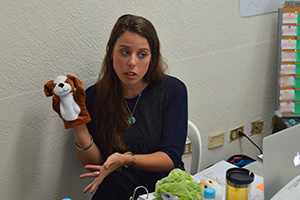They are bright and creative investigators, highly committed to improving world health.
But what makes some UCGHI GloCal Health fellows special is their street smarts and ability to get into tough communities and engage the people hardest hit by physical and social ills.
In Kisumu, in the western Nyanza region of Kenya, Jennifer Syvertsen interviewed people who inject drugs and drug peddlers where HIV risk is already too high.
In Hanoi, Vietnam, Huan Vinh Dong swabbed the throats of men at risk of sexually transmitted infections and weaved through motorbike-filled streets to deliver the fresh samples to a laboratory for culturing and analysis. In a city where antibiotics are overused, Dong was getting to the root of a possible drug-resistant bacteria.
In Culiacán, Mexico, the largest city and capital of the northwestern state of Sinaloa, Lauren Haack worked with educators and parents of kids with attention and behavioral concerns. The country has one of the highest school dropout rates in the world, and Haack piloted an intervention program so that youth with mental health issues linked to Attention Deficit Hyperactivity/Impulsivity Disorder (ADHD) are understood, helped and not shunned.
Since 2012, the UCGHI GloCal Health Fellowship program has placed and trained 71 young researchers in Africa, Asia and Latin America to tackle a wide range of public health issues – from HIV, malaria and diabetes to water contamination, family planning and mental health. Another 12 began their international research in July. The fellowships are sponsored by the Fogarty International Center, which is part of the National Institutes of Health.
Fellows from UC campuses and affiliated countries spend nearly a year with UC research partners in low- and middle-income countries. “Among the goals of the program is to strengthen global health networks and build countries’ capacity to tackle their most pressing health issues,” said Craig Cohen, MD, MPH, co-director of UCGHI and director of the GloCal Health Fellowship program.
But the research is “borderless,” said Cohen. Lessons learned – and solutions found – in one country, certainly can apply in many others, including the U.S.
Drug epidemic overseas and at home
When Jennifer Syvertsen started her fellowship in 2013, no other scientist had studied the patterns of drug injection and HIV risk in western Nyanza, Kenya, even though that region has the country’s highest HIV prevalence. Located on a major heroin trafficking route, Kenya has increasingly experienced local outbreaks of injection drug use, which threaten to exacerbate its ongoing HIV epidemic.

Syvertsen, a UC San Diego postdoctoral fellow at the time, had just completed studies in the Mexico-U.S. border region on HIV risk among female sex workers and their intimate partners, and she was ready for a new phase of HIV prevention research.
As an anthropologist, Syvertsen has a knack for digging for data in the right places. Here, it was in the neighborhoods and streets, where outsiders rarely ventured. “When I came, I had to immerse myself in local Kenyan culture,” said Syvertsen, whose research takes the ethnographic approach. “I had to build relationships and trust, so that people would open up to me about everything in their day-to-day lives.”
By the end of her study, she had surveyed more than 150 injection drug users and interviewed dozens in depth to understand patterns and factors that influenced them to inject drugs. She described a chaotic and emerging drug market in the region where the majority of participants reported injecting cocaine rather than heroin, which had been the focus of attention. She also described how drug peddlers often injected clients themselves – not knowing if needles were sterile -- and an East African practice in which a person who has just injected transfers his or her blood to another to share the drug’s effect.
Syvertsen shared her research findings at meetings of scientists and policymakers, and one non-governmental organization pledged to support the first needle exchange program in western Kenya. She hopes her research leads to other programs, such as injection drug prevention education and addiction treatment programs.
After her work in Kenya, Syvertsen joined the faculty at Ohio State University in 2014 and received funding to study the opioid epidemic in her home state. Southern Ohio is a center of the U.S. opioid epidemic, where “pill mills” and over-prescribing of drugs have precipitated shifts toward heroin injection.
Overall, her research aims to “reduce the harms associated with drug use,” said Syvertsen, who this fall accepted a faculty appointment to the anthropology department at UC Riverside. “Criminalizing it and putting people in jail doesn’t do anything for people already addicted.”
Ground zero for drug-resistant bacteria?
In his senior year at UC Berkeley 10 years ago, Huan Vinh Dong fulfilled a dream to return to Vietnam where he was born. He went as a volunteer English teacher and later joined a medical mission in the country’s rural hills. The experience moved him to a career path in medicine and health sciences research.

Dong, who is now a third-year student at the Charles R. Drew/UCLA medical education program, returned to his native land in 2016 as a GloCal fellow. He studied how infectious organisms, such as Neisseria gonorrhoeae (NG) – one of the world’s most prevalent sexually-transmitted infections – can potentially swap resistant genetic materials with non-pathogenic organisms when mingled with cephalosporins, a class of antibiotics used increasingly in Asia.
“When I first came to Vietnam for a short project after my first year of medical school, I was surprised how antibiotics were so readily available without a prescription,” he said. “There, it’s such a common practice to use antibiotics, even for a simple cold. You can get them from stores at almost every corner.”
For his study, he established a new partnership with Hanoi Medical University and the National Hospital for Tropical Diseases, which had previously studied antibiotic usage in some villages and the possible chain of harmful effects. But Dong was able to capture some crucial data about non-pathogenic Neisseria, and it had to come from men who have sex with men, a group that is socially marginalized and thus hesitant to disclose sexual behaviors and their drug use.
Dong hit the streets to survey and test more than 200 men at risk for sexually transmitted infections. He designed a simple questionnaire on tablets, which aimed to reduce reporting bias that may occur when subjects have to personally share sensitive answers with an interviewer.
Indeed, 15 percent had a history of gonorrhea and 63 per cent were using antibiotics – half of those within 30 days, and most without a prescription. Through his dynamically populated questionnaire instrument, Dong was able to collect information on antibiotic use, substance use and sexual behavior trends throughout the year.
The key and unique data collected were in throat cultures -- and the swab procedure is not always comfortable for study participants or the collector. Dong supposes that in this high-risk group, the throat could be a “swap meet” between NG and antibiotic microbes that create a selective pressure for genetic changes and turn colonies of bacteria into dangerous anti-drug resistant strains. The cultures were a critical part of the laboratory science end of the research.
To get that many willing and cooperative research participants was remarkable. Perhaps it’s because Dong is a skilled and persuasive communicator with a gift for outreach. With a degree in theater arts as well as a and masters in human nutrition and metabolic biology, he honed talents over the years as a performer in Kaiser Permanente's Education Theatre and volunteer at places like the Berkeley Free Clinic.
Even with a busy medical school schedule, he is working on his data analysis and manuscripts. He has presented preliminary results at three international meetings, with another poster presentation at one of the largest infectious disease meetings this fall. He already has offered research questions and a model for more comprehensive studies of antibiotic resistance – abroad and in the U.S.
In the U.S. alone, antibiotic-resistant bacteria cause more than two million illnesses and 23,000 deaths annually. In 2014, the U.S. Centers for Disease Control and Prevention announced a “National Strategy to Combat Antibiotic Resistance.” One of the strategies is to “improve international collaboration and capacities for antibiotic resistance prevention, surveillance, control and antibiotic research and development.”
The CDC has named drug-resistant NG as one of the top three antibiotic resistance threats. “It’s clearly a global health problem,” said Dong. “Bacteria do not care about borders or walls.”
Paying attention to more than the kids
School-aged children with ADHD exhibit a range of symptoms and behaviors that could turn into serious academic and social impairments at school, home and other settings. As they grow older, studies show, they are at higher risk for school failure, early drop-out and juvenile delinquency.

Lauren Haack offers a model for helping kids with ADHD: treat their parents, caregivers and teachers.
As a 2016 GloCal fellow, she piloted a culturally sensitive school-home program for Mexican kids with attention and behavior issues. ADHD affects some 5 to 10 percent of children worldwide. Latino youth, said Haack, are especially hard hit by mental health disparities from poor identification of the condition and lack of services for kids. In Mexico, the school dropout rate in some areas is as high as 50 percent.
Often, parents of kids with ADHD become frustrated and exhibit negative and ineffective parenting, and conflict between kids and parents runs high. In school, students with ADHD can be inattentive, disorganized or disruptive, and teachers and administrators may punish rather than manage them.
Haack’s program recruited 32 students in first through fifth grades, along with family members and school personnel in a six-week program. Behavior management efforts were based on a Collaborative Life Skills (CLS) program, developed by her mentor, Linda Pfiffner, PhD, UCSF professor of psychiatry.
Educational videos were shown to parents and teachers, and after viewing, some said “that’s my child and me,” and volunteered for the study, said Haack. The program included student, teacher and parent skills-building and integrated behavioral programs in the classroom, on the playground and at home.
Parents, for example, learned “positive strategies,” including praise and rewards for completing chores and homework. Teachers used individually designed “daily report cards,” to target and manage behaviors such as turning in homework, following directions and getting along with others.
In the end, “the outcomes and improvements were significant,” said Haack, who just recently was appointed as assistant clinical professor of psychiatry at UCSF.
Her co-researchers in Mexico will continue the efforts. “It’s about capacity building. Once you train someone, you can replicate, again and again.”
In San Francisco, Haack and Pfiffner are implementing and studying the CLS program in schools with large numbers of Spanish-speaking children.
She likens the collaborative behavior management approach to making a cake. “Instead of the eggs, sugar and flour, you have kids, parents and teachers,” she said. “Mix them all together and you get something magical.”
Like much of global health research, the sum is greater than the parts.
